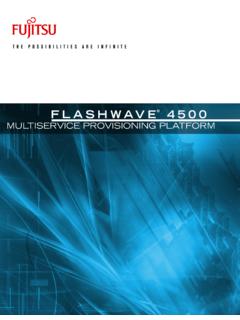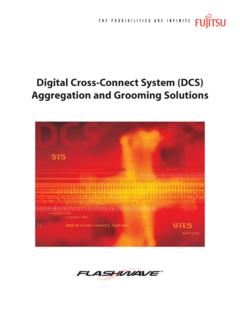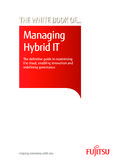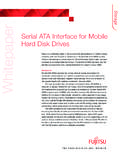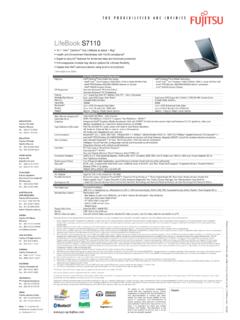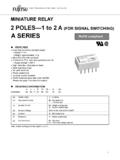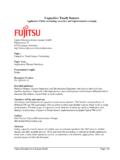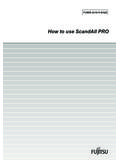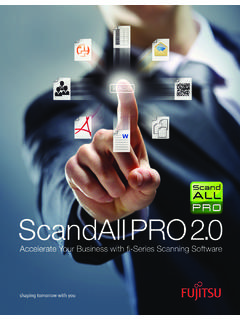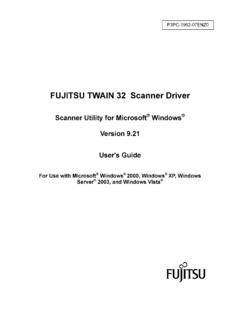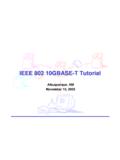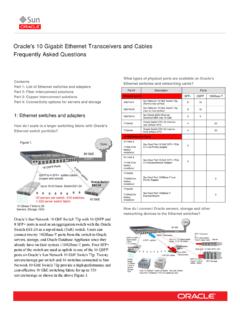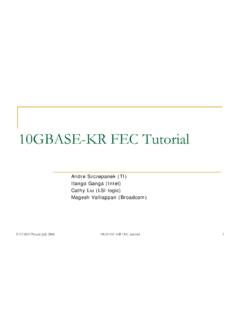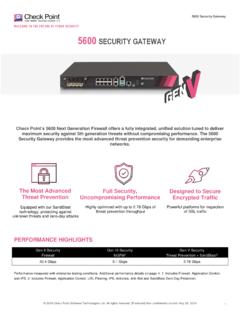Transcription of New Ethernet Tutorial - fujitsu.com
1 Ethernet Tutorial Ethernet April 11, 2006. Trademarks and Copyrights Acrobat and Reader are registered trademarks of Adobe Systems, Incorporated AppleTalk is a registered trademark of Apple Computer NetBIOS is a registered trademark of the IBM corporation NetBUEI is a registered trademark of the IBM Corporation UNIX is a registered trademark of UNIX. System Laboratories, Inc., and is exclusively licensed by the X/Open Company, Ltd. Windows is a registered trademark of the Microsoft Corporation Windows NT is a registered trademark of the Microsoft Corporation All other products or services mentioned in this document are identified by the trademarks, service marks, or product names as designated by the companies that market those products or services or own those marks. Inquiries concerning such products, services, or marks should be made directly to those companies. This document and its contents are provided by fujitsu Network Communications Inc.
2 ( fujitsu ) for guidance purposes only. This document is provided as is with no warranties or representations whatsoever, either express or implied, including without limitation the implied warranties of merchantability and fitness for purpose. fujitsu does not warrant or represent that the contents of this document are error free. Furthermore, the contents of this document are subject to update and change at any time without notice by fujitsu , since fujitsu reserves the right, without notice, to make changes in equipment design or components as progress in engineering methods may warrant. No part of the contents of this document may be copied, modified, or otherwise reproduced without the express written consent of fujitsu . Unpublished work and only distributed under restriction. Copyright fujitsu Network Communications Inc. All Rights Reserved. Tutorial Ethernet Introduction .. 1 Ethernet Networks.
3 22. Distribution Method .. 1 22. Ethernet .. 3 WAN .. 22. Ethernet History .. 3 Private 23. Ethernet Standards .. 3 ELINE .. 23. Fast Ethernet .. 4 ELAN .. 23. Gigabit 4 Metro Ethernet Forum .. 23. 10 Gigabit 5 25. LAN 5 VLAN Tagging .. 25. WAN PHY .. 5 Ethernet 27. 10 GBase Interfaces .. 5 Tree Topology .. 27. LAN PHY/WAN PHY 7 Ethernet Over SONET .. 29. Physical Coding Sublayer .. 7 The MAN/WAN 29. Physical Medium 7 Encapsulated 31. Physical Medium Dependent .. 7 Concatenated 31. Ethernet Frames .. 9 Differential Delay .. 31. Ethernet Address .. 9 EOS Protocols .. 33. Ethernet 10 LAPS .. 33. Full Duplex .. 11 GFP .. 33. Ethernet Equipment .. 12 EOS Advantages .. 34. Bridges .. 12 Ethernet Acronyms .. 35. 12 Ethernet Acronyms (Cont) .. 36. 13. Tutorial Review .. 37. Hubs/Repeaters .. 13. Ethernet Protocols .. 15 Review Answers .. 41. IP Addresses .. 17. Subnet Mask .. 17. Network Classes .. 17. Dot Address.
4 17. Spanning Tree Protocol .. 18. Rapid Spanning Tree 19. Ethernet Media .. 21. Issue 3, April 11, 2006 iii Ethernet Tutorial iv Issue 3, April 11, 2006. Tutorial Ethernet Introduction This self-study Tutorial on Ethernet and Ethernet over SONET Distribution Method satisfies a prerequisite needed for attendance at fujitsu Educational Services training. The Tutorial gives a general The Ethernet Tutorial can be viewed using Acrobat Reader and overview of Ethernet : is available at the following Internet address: History Standards Additional tutorials are available at these sites: Frames ATM: Access Protocols SONET: Media Networks Topologies Equipment Additionally, the Tutorial provides specific SONET information as it relates to transporting Ethernet over SONET. The Tutorial ends with a 25-question review of the information covered in the Tutorial . Any student who completes the Tutorial can answer the review questions and, by missing no more than four questions, satisfy a prerequisite requirement for fujitsu courses.
5 If more than four questions are missed, the student should revisit the Tutorial to ensure familiarity with all concepts and terms in the Tutorial before attending class. Issue 3, April 11, 2006 fujitsu and fujitsu Customer Use Only 1. Ethernet Tutorial Table 1: Ethernet Standards Supplement Year Description 1985 10 Base-2 (thin Ethernet ). 1986 10 Mb/s repeater specifications (clause 9). 1987 FOIRL (fiber link). 1990 10 Base-T (twisted pair). 1993 10 Base-F (fiber optic). 1995 100 Base-T (Fast Ethernet and autonegotiation). 1997 Full duplex 1998 1000 Base-X (Gigabit Ethernet ). 1999 1000 Base-T (Gigabit Ethernet over twisted pair). 1998 VLAN tag (frame size extension to 1522 bytes). 2000 Parallel links (link aggregation). 2002 10-Gigabit Ethernet 2004 Ethernet in the first mile 2005 Frame expansion 2005 Power over Ethernet Plus 2 fujitsu and fujitsu Customer Use Only Issue 3, April 11, 2006. Tutorial Ethernet Ethernet Ethernet , a physical layer local area network (LAN) technology, is Ethernet Standards nearly 30 years old.
6 In the last three decades, it has become the most widely used LAN technology because of its speed, low cost, The first Metcalfe system ran at Mb/s, but by 1980 DEC, and relative ease of installation. This is combined with wide Intel, and Xerox (DIX) issued a DIX Ethernet standard for 10 Mb/s Ethernet systems. That same year, the Institute of computer-market acceptance and the ability to support the Electrical and Electronics Engineers (IEEE) commissioned a majority of network protocols. committee to develop open network standards. In 1985, this Ethernet History committee published the portion of the standard pertaining to Ethernet (based on the DIX standard) IEEE Carrier Robert Metcalfe, an engineer at Xerox, first described the Sense Multiple Access with Collision Detection (CSMA/CD). Ethernet network system he invented in 1973. The simple, yet Access Method and Physical Layer Specifications. Even though innovative and, for its time, advanced system was used to the IEEE title does not mention Ethernet , Metcalfe's original term interconnect computer workstations, sending data between for his network system had caught on, and IEEE was and workstations and printers.
7 Is referred to as the Ethernet standard. Metcalfe's Ethernet was modeled after the Aloha network Note: The IEEE standard was called 802 because developed in the 1960s at the University of Hawaii. However, his work on it started in February 1980. system detected collisions between simultaneously transmitted frames and included a listening process before frames were As described in Table 1, many more Ethernet standards have been created since 1985. The IEEE standards have been transmitted, thereby greatly reducing collisions. adopted by the American National Standards Institute (ANSI) and Although Metcalfe and his coworkers received patents for by the International Organization of Standards (ISO). ISO. Ethernet and an Ethernet repeater, and Ethernet was standardization means that companies and organizations around wholly-owned by Xerox, Ethernet was not designed nor destined the world use these standards when manufacturing Ethernet to be a proprietary system.
8 It would soon became a worldwide products and installing Ethernet network systems. standard. Issue 3, April 11, 2006 fujitsu and fujitsu Customer Use Only 3. Ethernet Tutorial Fast Ethernet Gigabit Ethernet While 10 Mb/s seemed very fast in the mid-1980s, the need for Gigabit Ethernet works much the same way as 10 Mb/s and speed resulted in a 1995 standard (IEEE ) for 100 Mb/s 100 Mb/s Ethernet , only faster. It uses the same IEEE Ethernet over wire or fiber-optic cable. Although the 100 Base-T frame format, full duplex, and flow control methods. Additionally, standard was close to 10 Base-T, network designers had to it takes advantage of CSMA/CD when in half-duplex mode, and it determine which customers needed the extra bandwidth. supports simple network management protocol (SNMP) tools. Because there was a choice of bandwidths, the standard also Gigabit Ethernet takes advantage of jumbo frames to reduce the allowed for equipment that could autonegotiate the two speeds.
9 Frame rate to the end host. Standard Ethernet frame sizes are In other words, if an Ethernet device was transmitting or between 64 and 1518 bytes. Jumbo frames are between 64 and receiving from a 10 Mb/s network, it could support that network. If 9215 bytes. Because larger frames translate to lower frame the network operated at 100 Mb/s, the same device could switch rates, using jumbo frames on Gigabit Ethernet links greatly automatically to the higher rate. Ethernet networks then could be reduces the number of packets (from more than 80,000 to less 10 Mb/s or 100 Mb/s (Fast Ethernet ) and connected with than 15,000 per second) that are received and processed by the 10/100 Mb/s Ethernet devices that automatically switched end host. network speeds. Gigabit Ethernet can be transmitted over CAT 5 cable and optical fiber such as the following: 1000 Base-CX Short distance transport (copper). 1000 Base-SX 850 nm wavelength (fiber optics).
10 1000 Base-LX 1300 nm wavelength (fiber optics). 4 fujitsu and fujitsu Customer Use Only Issue 3, April 11, 2006. Tutorial Ethernet 10 Gigabit Ethernet The operation of 10 Gigabit Ethernet is similar to that of lower WAN PHY. speed Ethernets. It maintains the IEEE Ethernet frame size and format that preserves layer 3 and greater protocols. The WAN PHY supports connections to circuit-switched SONET. However, 10 Gigabit Ethernet only operates over point-to-point networks. Besides the sublayers added to the LAN PHY. (discussed in the following two pages), the WAN PHY adds links in full-duplex mode. Additionally, it uses only multimode and another element called the WAN interface sublayer (WIS). The single mode optical fiber for transporting Ethernet frames. WIS takes data payload and puts it into a Gb/s frame Note: Operation in full-duplex mode eliminates the that can be transported at a rate of Gb/s. The WIS does need for CSMA/CD.
